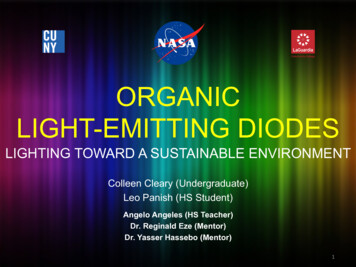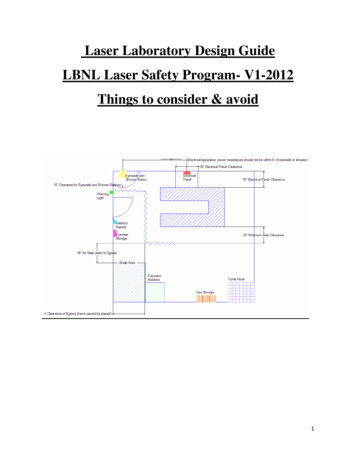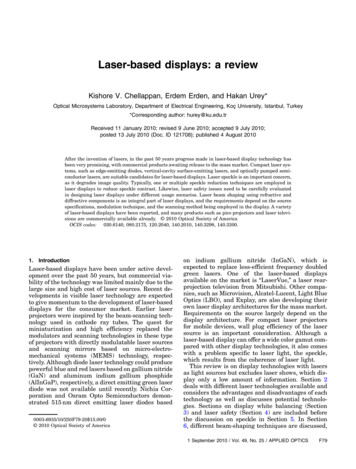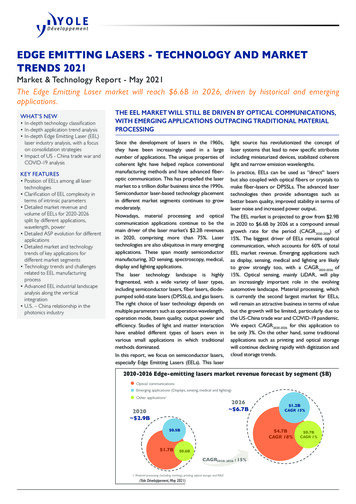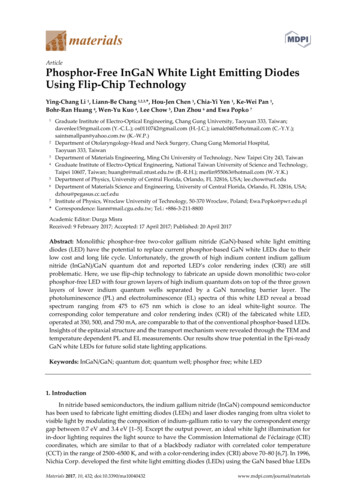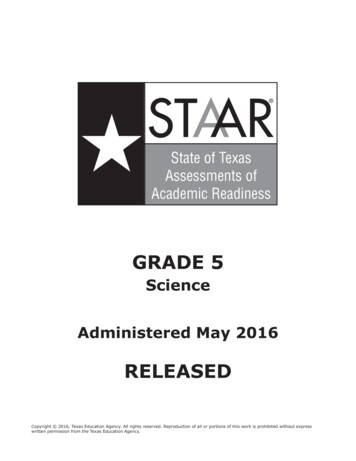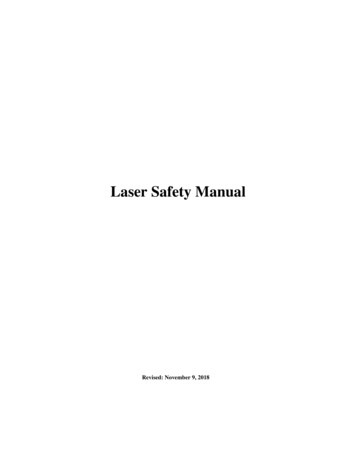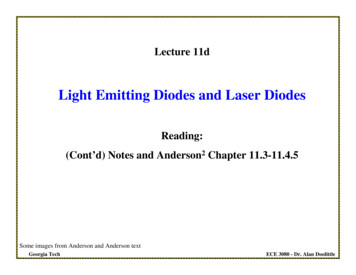
Transcription
Lecture 11dLight Emitting Diodes and Laser DiodesReading:(Cont’d) Notes and Anderson2 Chapter 11.3-11.4.5Some images from Anderson and Anderson textGeorgia TechECE 3080 - Dr. Alan Doolittle
Optical Design ChoicesSome semiconductor materials and their wavelength ranges. Based on data from References 3 to 5.Georgia TechECE 3080 - Dr. Alan Doolittle
P-n Junction I-V CharacteristicsIn Equilibrium, the Total current balances due to the sum of the individual componentsElectron DriftCurrentHole DiffusionCurrentGeorgia TechElectron DiffusionCurrentHole DriftCurrentECE 3080 - Dr. Alan Doolittle
Review: p-n Junction I-V CharacteristicsElectron DriftCurrentHole DiffusionCurrent flow is CurrentElectron DiffusionCurrentCurrent flowHole DriftCurrentis proportionalto e(Va/Vref) dueto theexponentialdecay ofcarriers intothe majoritycarrier bandsdominated by majoritycarriers flowing acrossthe junction andbecoming minoritycarriersQuickTime MovieGeorgia TechECE 3080 - Dr. Alan Doolittle
Review: p-n Junction I-V CharacteristicsCurrent flowis constantdue tothermallygeneratedcarriers sweptout by Efields in thedepletionregionElectron DriftCurrentElectron Diffusion Current negligible dueto large energy barrierHole Diffusion Current negligibledue to large energy barrierCurrent flow isdominated by minoritycarriers flowing acrossthe junction andbecoming majoritycarriersGeorgia TechHole DriftCurrentQuickTime MovieECE 3080 - Dr. Alan Doolittle
Review: p-n Junction I-V CharacteristicsWhere does the reverse bias current come from? Generation nearthe depletion region edges “replenishes” the current source.Georgia TechECE 3080 - Dr. Alan Doolittle
Review: p-n Junction I-V CharacteristicsPutting it all togetherForward Bias: Current flow isproportional to e(Va/Vref) due to theexponential decay of carriers intothe majority carrier bandsReverse Bias: Current flow isconstant due to thermallygenerated carriers swept out byE-fields in the depletion regionCurrent flow is zero at no applied voltageI Io(eVa/Vref - 1)Georgia TechECE 3080 - Dr. Alan Doolittle
Light Emitting Devices – Basics Emission of photons by recombination of electrons and holes in directbandgap materialsPhotoluminescense: excess electrons and holes required for the radiativerecombination are generated by photon absorptionElectroluminescense: excess electrons and holes required for the radiativerecombination are result of an electrical currentwww.osram.comGeorgia TechSlide Credit to Dr. Oliver Brandt, Ga TechECE 3080 - Dr. Alan Doolittle
LED ApplicationsLED DisplaysLED TextLED Brake LightsGeorgia TechSlide Credit to Dr. Oliver Brandt, Ga TechLED Head LightsECE 3080 - Dr. Alan Doolittle
and at Georgia Tech?Georgia TechSlide credited to Dr. Oliver Brandt, Ga TechECE 3080 - Dr. Alan Doolittle
Diode Applications: LED or a Laser DiodeILight Emissionunder forward BiasV1 IRR 1000 ohmsVAV 9VDiode made from a directbandgap semiconductor.Quantum well made fromsmaller bandgap materialElectron CurrentP-typeAl0.5Ga0.5As-qVAFNGaAsLightFPHole CurrentGeorgia TechN-typeAl0.5Ga0.5AsNote: These devices may not be asimple p-n type diode, but behaveelectrically identical to a p-njunction diode.Majority Carriers that are injected to the opposite sideof the diode under forward bias become minoritycarriers and recombine. In a direct bandgap material,this recombination can result in the creation ofphotons. In a real device, special areas are used to trapelectrons and holes to increase the rate at which theyrecombine. These areas are called quantum wells.ECE 3080 - Dr. Alan Doolittle
MQW LED Design ConsiderationsQuantum well made fromsmaller bandgap materialP-typeAl0.5Ga0.5AsElectron Current-qVAGaAsFPFNLightHole Current Number of wells is limited to 3-5 due toinefficient filling of injected carriers across inlast few wells.N-typeAl0.5Ga0.5As Light wavelength can be tuned by quantumconfined energy state effect discussed earlier(only useful for very narrow wells).Georgia TechECE 3080 - Dr. Alan Doolittle
MQW LED Design ConsiderationsNakamura, S. et al., “High-power InGaN single-quantum-well-structure blue and violetlight-emitting diodes,” Appl. Phys. Lett 67, 1868 (1995).Georgia Tech The shape of the “die” (chip) can greatlyaid light extraction by minimizing internalreflectionsECE 3080 - Dr. Alan Doolittle
Homojunction LED Design ConsiderationsElectron CurrentP-type GaPOFN-qVAFPLightZnN-type GaPHole Current Efficient light generation results from Donor-Acceptor pair transition – requires highdoping level so Donor and acceptor are “close to each other”.Georgia TechECE 3080 - Dr. Alan Doolittle
Blue LED based on AlGaInNSze, Figure 9.10 AlGaInN: direct bandgap ranging from 0.65 eV to 6.2 eV corresponding towavelength from 1.9 µm to 0.2 µmChallenge: find lattice-matched substrateSolution: sapphire substrate with AlN buffer layerBecause sapphire is non-conducting, both contacts are from the surfaceBlue light originates from radiative recombination in the GaxIn1-xN layerGeorgia TechSlide Credit to Dr. Oliver Brandt, Ga TechECE 3080 - Dr. Alan Doolittle
The LED Development2002 NationalMedal of Technologyfor R. Dupuis,School of ECEGeorgia TechSlide Credit to Dr. Oliver Brandt, Ga TechECE 3080 - Dr. Alan Doolittle
How to Make White LEDs?Georgia TechSlide Credit to Dr. Oliver Brandt, Ga TechECE 3080 - Dr. Alan Doolittle
PhotodiodeReversed Bias Diode with no lightilluminationGeorgia TechReversed Bias Diode WITH lightillumination results in “extra” driftcurrent due to photogenerated ehp’sthat can reach the junction.ECE 3080 - Dr. Alan Doolittle
PhotodiodeI total I dark I Due to LightI totalI total VD VT I o e 1 I Due to Light VD VT I oe I o ( qA)(LN W LP )GLLightNo-LightIEvery EHP createdwithin the depletionregion (W) andwithin a diffusionlength away from thedepletion region iscollected (sweptacross the junctionby the electric field)as photocurrent(current resultingfrom light). All otherEHP’s recombinebefore they can becollected.No-LightVBias PointLightGeorgia TechECE 3080 - Dr. Alan Doolittle
Semiconductor LED vs LASER? Light Emitting Diode Light is mostly monochromatic (narrow energy spread comparable to the distribution ofelectrons/hole populations in the band edges) Light is from spontaneous emission (random events in time and thus phase). Light diverges significantly LASER Light is essentially single wavelength (highly monochromatic) Light is from “stimulated emission” (timed to be in phase with other photons Light has significantly lower divergence (Semiconductor versions have more than gaslasers though).Georgia TechECE 3080 - Dr. Alan Doolittle
LED HistoryPresent LED technology is more efficient than evenfluorescent lamps! However, it will take some time before thecost comes down enough to replace light bulbs.Georgia TechECE 3080 - Dr. Alan Doolittle
LED A pn junction in a direct bandgap material will produce light when forward biased.However, re-absorption (photon recycling) is likely and thus should be avoided. Use of quantum wells in the “active region” (region where minority carriers areinjected and recombine from the “majority carrier” anode (source of holes) and cathode(source of electrons) results in minimal re-absorption since the emitted light is belowthe bandgap of the cladding layers (higher bandgap regions). The quantum well also strongly confines the electrons and holes to the same region ofthe material enhancing the probability of recombination and thus enhancing theradiation efficiency (light power out/electrical power in).Georgia TechECE 3080 - Dr. Alan Doolittle
LED Often Multiple QWs are used to insure radiation efficiency. Typically 3-5 QWsmaximize the light output since holes are injected from the p-side and electrons fromthe n-side and thus would get trapped in different wells if we had too many QWs. Some real effects to consider:– Some semiconductors (Nitrides and Carbides) are polar materials. Thus, heterojunctionsmust contend with polarization discontinuities (changes in polarization) at the interfaces.This leads to spikes in the band diagrams and strong electric fields in the QW that canpartially separate the electron wave function from the hole wave function loweringradiation efficiency.– Often, an electron blocking layer is introduced via a wide bandgap layer near the anode(p-side). This prevents electrons (which have higher diffusivity than holes) from enteringthe anode (p-side) thus limiting recombination “at the wrong wavelength” enhancingcolor purity and desired light power efficiency.Georgia TechECE 3080 - Dr. Alan Doolittle
Light Scattering in an LEDA generic surface-emitting LED. Some photons are lost by re-absorption in the bulk, Fresnel reflection fromthe surface, and total internal reflection.Georgia TechECE 3080 - Dr. Alan Doolittle
A fiber coupled LED A Burrus-type LED. This one uses adouble heterostructure to confine thecarriers, making recombinationmore efficient. The etched opening in theLED helps align and couple an opticalfiber.Typically InGaAs active layers are usedto produce the IR light necessary totransmit in a fiber with minimal loss inthe fiber.Georgia TechECE 3080 - Dr. Alan Doolittle
Light Channeling (Waveguiding) in a LED In an edge-emitting LED, the higher refractive index active layer acts as a waveguide for photonstraveling at less than the critical angle.Why is re-absorption not a huge concern? Georgia TechECE 3080 - Dr. Alan Doolittle
LED Waveguides (edge emitting LED) The edge-emitting LED’s waveguide (a) supports only certain transverse modes, whose fielddistributions are shown in (b). In practice, only the first mode is allowed. It is not completely confined tothe active layer, thus its absorption is reduced.Georgia TechECE 3080 - Dr. Alan Doolittle
Spontaneous Light Emission We can add to our understanding of absorption and spontaneous radiation due torandom recombination another form of radiation – Stimulated emission.Stimulated emission can occur when we have a “population inversion”, i.e. when wehave injected so many minority carriers that in some regions there are more “excitedcarriers” (electrons) than “ground state” carriers (holes).Given an incident photon of the bandgap energy, a second photon will be “stimulated”by the first photon resulting in two photons with the same energy (wavelength) andphase.This phase coherence results in minimal divergence of the optical beam resulting in adirected light source.Georgia TechECE 3080 - Dr. Alan Doolittle
Spontaneous vs Stimulated LightEmissionThe power-current curve of a laser diode. Below threshold, the diode is an LED. Above threshold, thepopulation is inverted and the light output increases rapidly.Georgia TechECE 3080 - Dr. Alan Doolittle
Using Mirrors and Optical Gain(through Stimulated emission) to“Amplify the Light”The ends of the chip form partially reflective mirrors, which allows the photons to be reflected back andforth and thus be exposed to gain for a longer period of time.Georgia TechECE 3080 - Dr. Alan Doolittle
Cavity Modes used in WavelengthSelectionWavelengths that are integer multiples of half the cavity’s length can resonate, interfering constructively.Other wavelengths die out eventually.Georgia TechECE 3080 - Dr. Alan Doolittle
Cavity Modes used in WavelengthSelectionThe resonances of a Fabry-Perot cavity. The width of the resonances depends on the reflectivity R of themirrors.Georgia TechECE 3080 - Dr. Alan Doolittle
Cavity Modes Gain Result inWavelength SelectionDevelopment of lasing. (a) The gain distribution is the same as the spontaneous emission spectrum. (b) Onlythe photons at the resonance will amplify. The ones near the center of the gain curve will amplify the fastest.Georgia TechECE 3080 - Dr. Alan Doolittle
LASER Wavelength DesignAdjusting the depth and width of quantum wells to select the wavelength of emission is one form of band-gapengineering. The shaded areas indicate the width of the well to illustrate the degree of confinement of themode.Georgia TechECE 3080 - Dr. Alan Doolittle
Stripline or Edge Emitting LASERThe output pattern of a simple “stripline”, edge-emitting laser is elliptical and widely divergent.Georgia TechECE 3080 - Dr. Alan Doolittle
Advanced LASER Wavelength Design (a) A GRINSCH structure helps funnel the carriers into the wells to improve the probability ofrecombination. Additionally, the graded refractive index helps confine the optical mode in the nearwell region. Requires very precise control over layers due to grading. Almost always implementedvia MBE(b) A multiple quantum well structure has improves carrier capture.Sometimes the two are combined to give a “digitally graded” device where only two compositions areused but the well thicknesses are varied to implement an effective “index grade”Georgia TechECE 3080 - Dr. Alan Doolittle
Vertical Cavity Surface Emitting Laser(VECSEL) A vertical cavity surface-emitting laser. (After Ueki et al., IEEE Photonics Technology Letters, 11, no. 12,pp. 1539–1541, 1999, IEEE.)Distributed Bragg Reflectors (DBR) mirrors require very precise growth control. Refreactive index isvaried as much as possible (while still remaining electrically conductive) and must be a precise fractionof a wavelengthGeorgia TechECE 3080 - Dr. Alan Doolittle
DFB LASERThe distributed feedback (DFB) laser uses a grating to provide continuous feedback along the laser cavity.Georgia TechECE 3080 - Dr. Alan Doolittle
Light Emitting Diodes and Laser Diodes Reading: (Cont'd) Notes and Anderson2 Chapter 11.3-11.4.5 Some images from Anderson and Anderson text. . LED Applications LED Displays LED Brake Lights LED Head Lights LED Text Slide Credit to Dr. Oliver Brandt, Ga Tech. Georgia Tech ECE 3080 - Dr. Alan Doolittle
